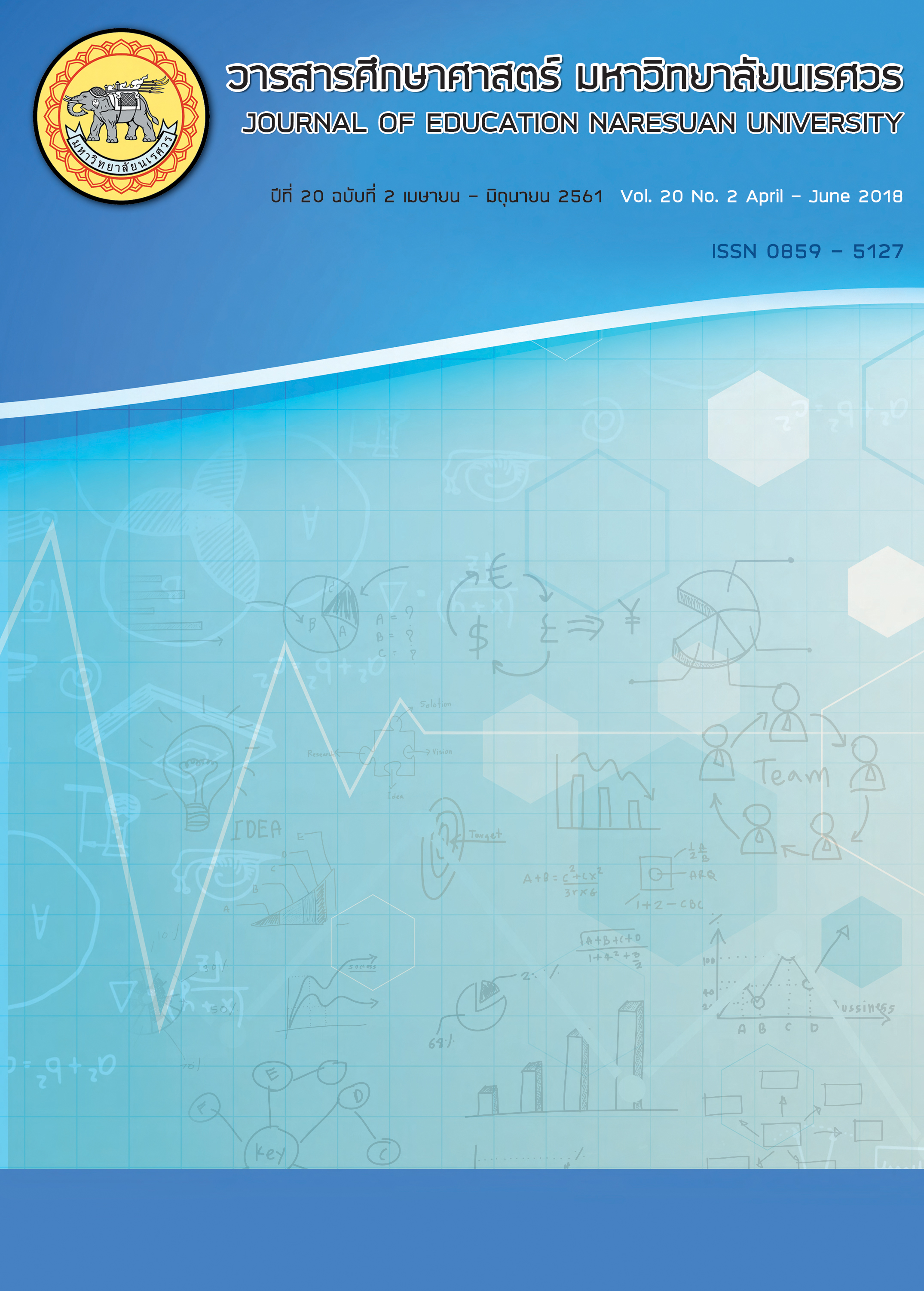การพัฒนาผลสัมฤทธิ์ทางการเรียนและความสามารถในการแก้โจทย์ปัญหา เรื่อง ปริมาณสารสัมพันธ์ ของนักเรียนชั้นมัธยมศึกษาปีที่ 4 โดยใช้รูปแบบการสอนแบบวัฏจักรการเรียนรู้ 7E ร่วมกับเทคนิค KWDL; DEVELOPMENT OF ACHIEVEMENT AND PROBLEM SOLVING ABILITY ON...
Main Article Content
Abstract
การศึกษาวิจัยครั้งนี้มีวัตถุประสงค์เพื่อศึกษาพัฒนาการด้านผลสัมฤทธิ์ทางการเรียนและความสามารถในการแก้โจทย์ปัญหา เรื่อง ปริมาณสารสัมพันธ์ ของนักเรียนชั้นมัธยมศึกษาปีที่ 4 โดยใช้รูปแบบการสอนแบบวัฏจักรการเรียนรู้ 7E ร่วมกับเทคนิค KWDL กลุ่มเป้าหมายในการวิจัยเป็นนักเรียนชั้นมัธยมศึกษาปีที่ 4/15 ภาคเรียนที่ 2 ปีการศึกษา 2558 โรงเรียนชลราษฎรอำรุง อำเภอเมือง จังหวัดชลบุรี จำนวน 49 คน โดยใช้รูปแบบการวิจัยเชิงปฏิบัติการ จำนวน 3 วงจร เครื่องมือที่ใช้ในการวิจัย ได้แก่ แผนการจัดการเรียนรู้ จำนวน 5 แผน แบบทดสอบวัดผลสัมฤทธิ์ทางการเรียน แบบทดสอบวัดความสามารถในการแก้โจทย์ปัญหาและแบบทดสอบย่อยท้ายวงจร การวิเคราะห์ข้อมูลใช้วิธีการศึกษาคะแนนพัฒนาการ ค่าเฉลี่ย ส่วนเบี่ยงเบนมาตรฐานและค่าร้อยละ ผลการวิจัย พบว่า
1. ผลสัมฤทธิ์ทางการเรียน เรื่อง ปริมาณสารสัมพันธ์ หลังเรียนมีพัฒนาการที่สูงขึ้นมีค่าเฉลี่ยร้อยละ 53.93 ซึ่งอยู่ในระดับสูง โดยเฉพาะด้านความเข้าใจมีพัฒนาการมากที่สุด ร้อยละ 74.83 รองลงมา คือ ด้านการนำไปใช้, ความรู้ความจำ, การสังเคราะห์, การประเมินค่าและการวิเคราะห์ ร้อยละ 56.81, 54.12, 51.02, 40.82 และ 40.74 ตามลำดับ
2. ความสามารถในการแก้โจทย์ปัญหา เรื่องปริมาณสารสัมพันธ์ หลังเรียนมีพัฒนาการที่สูงขึ้น มีค่าเฉลี่ยร้อยละ 59.09 ซึ่งอยู่ในระดับสูง โดยขั้นตอน K(Know) มีพัฒนาการมากที่สุด ร้อยละ 62.50 รองลงมา คือ D(Do), L(Learned) และ W(Want) ร้อยละ 61.99,50.61 และ 48.76 ตามลำดับ
DEVELOPMENT OF ACHIEVEMENT AND PROBLEM SOLVING ABILITY ON STOICHIOMETRY FOR GRADE 10 STUDENTS USING 7E LEARNING CYCLE WITH KWDL TECHNIQUE
The purpose of this research was to study a development of learning achievement and problem solving ability of grade 10 students using 7E learning cycle with KWDL technique. The target groups were 49 of grade 10 students in the second semester of academic year 2015 at Chonradsadornumrung School, Muang District, Chonburi Province. Research design is action research consisting of 3 spirals. The research instruments consist of 5 lesson plans, the learning achievement test, the problem solving ability test and the end of cycle test. The data were analyzed by growth scores, mean, standard deviation and percentage. The research findings were as follows:
1. The learning achievement on Stoichiometry had growth scores higher than those before learning by mean of 53.93% at a high level, especially the highest score of 74.83% in understanding, 56.81% in applying, 54.12% in remembering, 51.02% in synthesizing, 40.82% in evaluating and 40.74% in analyzing.
2. The problem solving on Stoichiometry had growth scores higher than those before learning by mean of 59.09% at a high level, especially the highest score of 62.50% in step K(Know), 61.99% in step D(Do), 50.61% in step L(Learn) and 48.76% in step W(Want).
Article Details
The owner of the article does not copy or violate any of its copyright. If any copyright infringement occurs or prosecution, in any case, the Editorial Board is not involved in all the rights to the owner of the article to be performed.
References
Eisenkraft, A. (2003). Expanding the 5E Model. The Science Teacher, 5(6), 57-59.
Gonen, S. (2006). The effect of the computer assisted teaching and 7E model of the constructivist learning methods on the achievements and attitudes of high school students. Retrieved May 15, 2015, from https://www.eric.ed.govdata/ericdocs2sql/content_storage_01/0000019b/80/3d/d5/aa.pdf
Kanjanawasee, S. (2013). Classical test theory (7th ed.). Bangkok: Faculty of Education, Chulalongkorn University. (in Thai)
Khunnuiy, S. (2012). Effects of using the 7E instructional model in chemistry activities on learning achievement and problem solving ability of Mathayomsuksa IV students. Journal of Education, 24(1), 37-48. (in Thai)
Khwotrakun, S. (2011). Psychology (10th ed.). Bangkok: Chulalongkorn University Press. (in Thai)
Kijkuakul, S. (2012). Nature of science and its learning benchmarks. Journal of Education Naresuan University, 14(3), 119-124. (in Thai)
Laowreandee, W. (2011). Thinking skills instructional models and strategies. Nakhon Pathom: Silpakorn University. (in Thai)
Learning Area of Science. (2014). The achievement in chemistry report. Chonburi: Chonradsadornumrung School. (in Thai)
Learning Area of Science. (2015). The achievement in chemistry report. Chonburi: Chonradsadornumrung School. (in Thai)
Ministry of Education. (2008). The Basic Education Core Curriculum B.E. 2551 (A.D. 2008). Bangkok: The Agricultural Cooperative Federation of Thailand. (in Thai)
Ra-Ngubtook, W. (1999). Rangubtook, W. (1999). Student - centered lesson plan. Bangkok: Ton Or. (in Thai)
Shaw, J. M., et al. (1997). Cooperative problem solving: Using K W D L as an organizational technique. Teaching Children Mathematics, 3(39), 482-486.
Sribanchuen, M., & Seehamongkon, Y. (2011). Comparisons of problem solving ability, analytical thinking ability and satisfaction with learning and teaching on one - variable linear equations of Matthayomsueksa 1 students using KWDL learning method and traditional approach. Journal of Education Graduate Studies Research Khon Kaen University, 5(4), 62-69. (in Thai)
Sutthirat, C. (2010). 80 Child centered learning innovation. Nonthaburi: P Balance D Science Printing. (in Thai)
The National Institute of Educational Testing Service (Public Organization). (2014). O-net test. Retrieved May 1, 2015, from https://www.niets.or.th/ (in Thai)
Wonganutrohd, P. (2005). Instructional supervision. Bangkok: Bangkok Media Center. (in Thai)
Wongwanich, S. (2006). Classroom action research. Bangkok: Chulalongkorn University Press. (in Thai)


